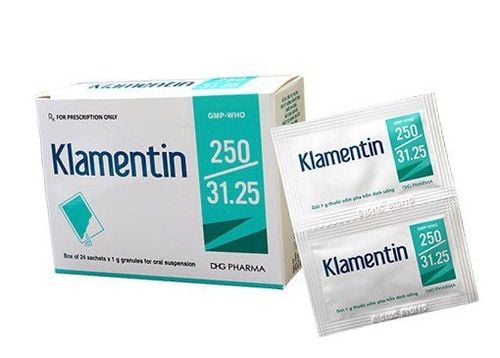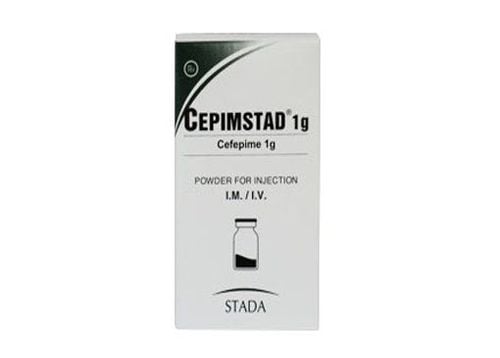This is an automatically translated article.
Mirapime is an antiparasitic, anti-infective, antifungal and antiviral drug. With the main active ingredient is Cefepime Hydrochloride, Mirapime is widely used for patients with infections of the lower respiratory tract, urinary tract, skin and skin structures, abdominal cavity, biliary tract, gynecology or sepsis. Mirapime is also used to treat neutropenic fever and bacterial meningitis in children.
1. What is the effect of Mirapime?
Mirapime is a powder for injection with the main ingredient being Cefepime Hydrochloride with a content of 1g per vial. Active ingredient Cefepime is an antibiotic of the beta lactam family, which has been clinically tested and shown to be effective against bacteria and parasites with strains from sensitive to resistant clearly. In each box of Mirapime, there will be 1 vial of powder containing powder and 1 ampoule of water for injection.
From the effect of Mirapime, Mirapime is indicated for use in both adults and children in the following cases:
Severe urinary tract infections with complications (including accompanying pyelonephritis); Severe pneumonia and associated sepsis caused by susceptible strains of bacteria; Severe infections of the skin and skin structures by strains such as Methicillin-susceptible Staphylococcus aureus and by Cefepime-susceptible strains of Streptococcus pyogenes; There are also infections of the abdominal cavity, biliary tract, gynecology...; Treatment of fever, leukopenia; Meningitis caused by bacteria in children. Miradone should not be used for the following subjects:
Patients who have or have a history of allergy to Cephalosporin, Penicillin or other B-lactam antibiotics.; Patients allergic to L-arginine (a component of the preparation); Hypersensitivity to the active substance Cefepime.
2. Instructions on how to take Mirapime
How to use: Can be injected intravenously slowly for 3-5 minutes or by intravenous infusion, deep intramuscular injection with a dose of Cefepime depending on the severity of each case.
Dosage:
For complicated urinary tract infections (including associated pyelonephritis) or severe skin and skin structure infections: Patients >12 years old, 2g intravenously, doses 12 hours apart, within 10 days; For severe pneumonia, including associated sepsis: 2g/time x 2 times/day 12 hours apart, used for 7-10 days; Dosage in patients with renal impairment: Patients with renal impairment (creatinine clearance <60ml/min), will start with the dose for patients with normal renal function. Maintenance dose should be calculated according to creatinine clearance (or patient's ClCr (measured or estimated) ClCr 30 - 60ml/min: Dose over 24 hours as usual dose; ClCr 10 - 30ml/min: Dosage in 24 hours will be 1/2 of the usual dose; ClCr <10ml/min: The dose in 24 hours is 1/4 of the usual dose.
3. Mirapime side effects
Besides the therapeutic uses, Mirapime can cause some common side effects such as:
Abdominal pain, diarrhea; Rash and pain at the injection site. Uncommon side effects of Mirapime:
Fever or headache; Eosinophilia, granulocytopenia or positive direct Coombs test without hemolysis; Thrombophlebitis (when administered intravenously); Nausea, vomiting, fungal or candidiasis of the mouth; Appearance of urticaria and itching; Increased liver enzymes (reversible); Sensation. Rare side effects of Mirapime:
Anaphylactic reactions, edema or dizziness; Neutropenia ; Hypotension or vasodilation; Colitis, pseudomembranous colitis and abdominal pain; Cramp; Confusion; Joint pain; Vaginitis ; Blurry vision; Tinnitus. What to do in case of unwanted effects? In the process of using Mirapime, if you experience any of the above symptoms or unusual symptoms, you should stop taking the drug and tell your doctor immediately for advice on the appropriate remedy.
In case of pseudomembranous colitis: Stop taking Mirapime and replace with another more suitable antibiotic such as vancomycin. Avoid the use of antidiarrheal drugs to relieve symptoms of side effects.
4. Notes when using Mirapime
Patients with a history of anaphylactic reactions to penicillin (about 5 - 10% of patients allergic to penicillin antibiotics will cross-allergic to cephalosporin antibiotics). In the case of severe infections that require β-lactam therapy, cephalosporins can be used in patients allergic to penicillins, but close monitoring and anaphylaxis should be available at all times. Consider dose reduction in patients with renal impairment. It is necessary to carefully inspect the Cefepime solution before using it for injection to see if there is a precipitate, to ensure the safety of using Mirapime. The efficacy and safety of Mirapime in children under 12 years of age have not been established.
5. Mirapime drug interactions
Amikacin when used in combination with the active ingredient Cefepime will have less risk of nephrotoxicity than Gentamicin or Tobramycin used in combination with Cefalotin. Do not use Mirapime at the same time as Furosemide because this combination will affect the user's hearing.
The article has provided information about what Mirapime is, dosage and precautions for use. Because Mirapime is a prescription drug, patients should not use it on their own, but need to contact a doctor or a qualified person directly to get an appropriate prescription to ensure safety for health.













